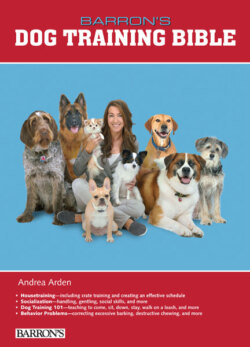Читать книгу B.E.S. Dog Training Bible - Andrea Arden - Страница 24
На сайте Литреса книга снята с продажи.
Stages of Development
ОглавлениеFor better or worse, dogs change as they mature in response to new experiences and potential challenges. Behavioral changes are usually most dramatic during transitions from puppyhood to adolescence, and then to adulthood. It can be challenging for owners to cope with these developmental stages. Just when you begin to make progress and feel your dog understands what is expected, he reaches the next stage of his life, and his behavior and response to the world changes. For example, an otherwise mild-mannered and sociable puppy may begin growling at people or other animals when he is six to nine months old.
Recognizing and accepting the fact that your dog will need your continuing guidance and support throughout his life will help prevent frustration and stress for both dog and family. If you have built a good foundation for a trusting and cooperative relationship with your dog, these emerging potential behavior issues should be less challenging.
Understanding the dog’s general developmental stages will prepare you for what to expect and give you the knowledge to properly manage and teach your dog during each phase of his life.
Puppyhood
Puppies, like other young creatures, are naturally playful, inquisitive, and eager to bond and learn. During this period they have the greatest potential for rapid learning, especially when guided by someone they trust. Every pup’s temperament is influenced by genetics, but he is essentially a clean slate; he has few preconceived notions of the world and little experience that could be used to form bad habits. From this perspective, training is simple and straightforward. It can be focused on teaching new, reliable behaviors rather than resolving behavior problems.
Raising a puppy can be a truly wonderful experience, but it also has challenges, including moments of serious frustration (and lack of sleep). Successfully raising a puppy requires a commitment to provide essential training and socialization during his critical learning stage, the first four months of life.
Puppyhood is the time to focus on socialization and instilling the foundation for basic manners. Subsequent training can focus on honing a dog’s skills and applying them to real-life situations.
Watch for certain predispositions in a young puppy’s character. A puppy’s personality forms slowly, but these clues will tell you if he has outstanding temperament traits, such as natural confidence or shyness.
• When encouraged to come, does the pup approach quickly, slowly, or move away?
• When you walk away, does the pup tend to follow you?
• Does the pup tend to relax, get excited, or freeze stiffly when he is picked up?
• When the pup enters an unfamiliar environment does he investigate, pause, cautiously approach, or attempt to hide?
• How does he react when exposed to loud noises?
At this age, extreme personality traits can be most easily modified through proper training and socialization.
Adolescence
The onset of adolescence varies, but as a general rule, smaller dogs reach mental and physical maturity earlier. Therefore, an adolescent Chihuahua is likely to be more mature than an Irish Setter or Great Dane of the same age.
PAWS TO CONSIDER
Dog’s can think logically, reason, learn from experience, and modify their behavior to influence others. For instance, your dog may present you with a toy to elicit a game of fetch.
Although dogs are very smart, they are definitely not capable of complicated planning required for spite and revenge. Dogs live in the moment. It is one of their best qualities. They forgive and forget, rather than bear a grudge or scheme to revenge a past wrong.
Much like a teenager, dogs between the ages of approximately four and nine months may seem more challenging. They are larger and stronger, which makes them more difficult to manage. They are also more energetic, confident, and agile. And, like teenagers, their behavior is influenced by hormonal surges (all the more reason to spay and neuter early).
This can be a frustrating time, and it will require much patience, nurturing, and guidance on your part. Good management and a structured routine will help your dog navigate this transition by making his world more predictable. A “Learn to Earn” program is especially helpful during this period of development.
It will gain your dog’s cooperation by leveraging his desire to have access to valued resources.
Adulthood
Adult dogs tend to fall into two categories; those that have benefited from early and ongoing guidance to learn how to behave, and those that have not.
Unfortunately, adult dogs who indulge in what most consider to be inappropriate behaviors, such as eliminating in the home, barking excessively, chewing inappropriate items, digging holes in the yard, raiding the garbage can, and counter surfing are often denied social interactions and freedoms. As a result, they have very few opportunities to learn better habits, and their behavior tends to further deteriorate. Many are ultimately surrendered to shelters, and their chances of finding new homes are small once they are unfairly labeled as problem dogs.
